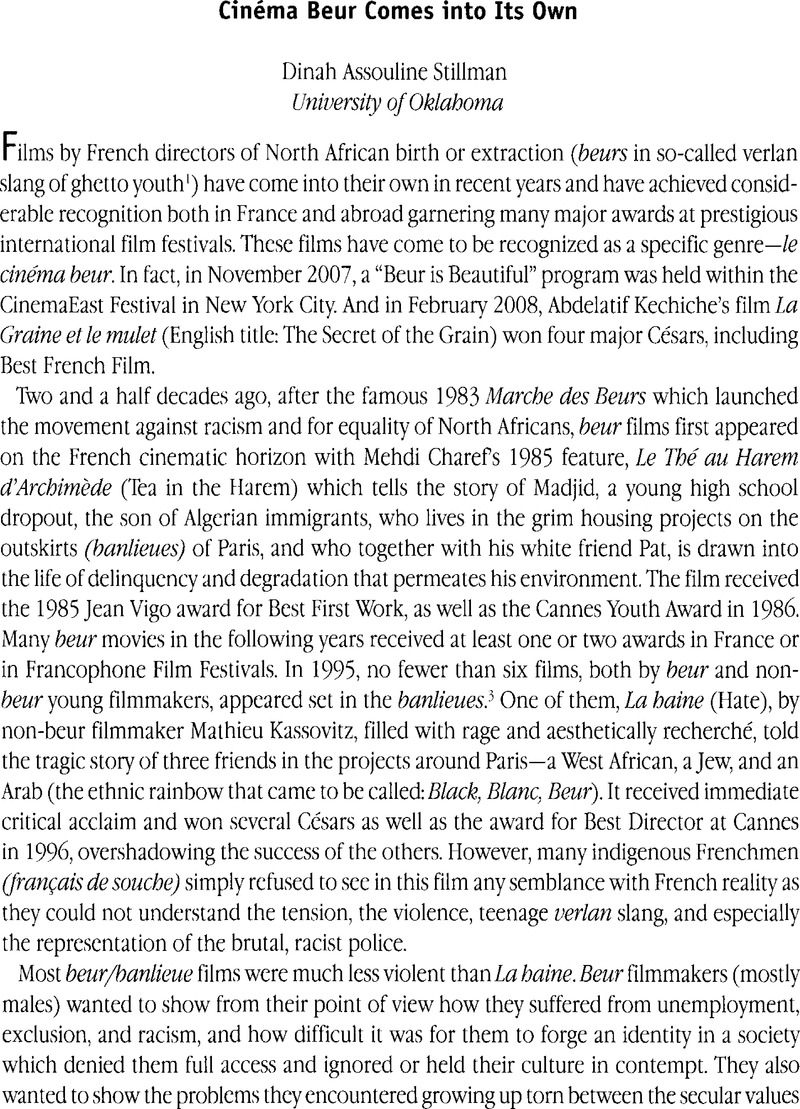Article contents
Cinéma Beur Comes into Its Own
Published online by Cambridge University Press: 09 March 2016
Abstract

- Type
- Arts Reviews
- Information
- Copyright
- Copyright © Middle East Studies Association of North America 2008
References
End Notes
1 Verlan (l’envers backwards) is a back slang that today has become hip. Beur is thus derived from Arabe. Since verlan has become so generally acceptable in the youth culture, a new reverse verlan has come into being with rebeuh, the reverse of beur now the designation of choice.
2 On this occasion, a special supplement to Cineaste 33:1 (Winter 2007) appeared, with detailed articles by Carrie Tarr, Bill Higbee, Jean-Pierre Jeancolas, Denis Provencher. A very comprehensive “Guide to Resources in beur-related cinema” by Elizabeth Ezra and Terry Rowden is also included.
3 Karim Dridi’s Bye-Bye; Malik Chibane’s Douce France; Ahmed Bouchaala’ Krim, and non-beur Jean-François Richet’s Etat de lieux, Thomas Gilou’s Raϊ and Mathieu Kassovitz’s La haine.
4 See Tarr, Carrie “Maghrebi-French (beur) Filmaking in context,” Cineaste 33:1, pp. 32–37.Google Scholar
5 See Higbee, Will “Re-Presenting the Urban Periphery: Maghrebi-French Filmaking and the Banlieue Film,” Cineaste, 33:1, pp. 38–43.Google ScholarDouble peine: Under French law, a delinquent originating from another country may be deported after judgment and not allowed to return to France. Therefore, they can only be illegal immigrants if they come back to France.
6 Farida Belghoul, a filmmaker and writer, made a few shorts, C’est Madame la France que tu préfères?. (You prefer Madame France?) in 1981, and Le depart du père (Father’s Departure), 1985, before stopping filming after the international success of her novel Georgette, 1986. Zaida Ghorab-Volta wrote and directed Souviens-toi de moi (Remember Me) in 1996, and Dounia in 1997, then went on writing and filming about non-beur characters in her subsequent works. Rachida Krim made an award-winning fictional film based on the story of her mother, when she was a fighter for her country’s independence, in her Sous les pieds des femmes (Under the Women’s Feet) in 1997, before working for French television. Djamila Sahraoui made highly acclaimed documentaries, among them La moitié du ciel d’Allah (The Other Half of Allah’s Heaven) in 1995, about Algerian women after independence. In 2006, she made an award-winning first feature film, Barakat (Enough!), about two different Algerian women who must fear the worst from the fundamentalists.
7 Interview with Alexander, Livia. Satya Magazine, May 2002.Google Scholar See also her interview with Barlet, Olivier, in French, in Africultures, September 1997,Google Scholar and her interview with Dupont, Joan in The Herald Tribune, entitled “Seeking an Identity in the Immigrant’s Silence,” March 31,1998.Google Scholar
8 His other films include: Baton Rouge (1985), Cheb (1991), Poussières de vie (1994), L’honneur de la famille (1997), and Little Sénégal (2001). Of these, only Baton Rouge, Cheb, and L’honneur de la famille have beur themes.
9 December 12, 2007. See also reviews by Douin, Jean-Louis of Le Monde, and by Murat, Bernard of Télérama, same date.Google Scholar
10 December 11, 2007.
11 For example Beur, Blanc, Rouge, by Mahmoud Zemmouri, Voisin, voisine, by Malik Chibane, Cartouches gauloises, by Mehdi Charef, Bled number one, by Ameur- Zaimeche, Rue des Figuiers (Where the Fig-trees Grow), by Yasmina Yahiaoui, and actor Roshdi Zem’s first feature, Mauvaise foi (Bad Faith) are among the very best.
12 The “Beur is Beautiful” Program, curated by Carrie Tarr, is available to universities, sponsored by the Cultural Services of the French Embassy with a list of significant Maghrebi-French films. For information, contact: Arteeast, www.arteeast.org.
- 1
- Cited by


